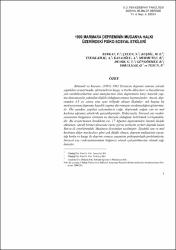| dc.contributor.author | Berkay, F. | |
| dc.contributor.author | Çelen, N. | |
| dc.contributor.author | Kuşdil, M.E. | |
| dc.contributor.author | Kayaoğlu, A. | |
| dc.contributor.author | Mermutlu, B. | |
| dc.contributor.author | Tosun, P. | |
| dc.date.accessioned | 2019-10-21T19:43:21Z | |
| dc.date.available | 2019-10-21T19:43:21Z | |
| dc.date.issued | 2003 | |
| dc.identifier.issn | 1302-2423 | |
| dc.identifier.uri | http://www.trdizin.gov.tr/publication/paper/detail/TXpRM05EUT0= | |
| dc.identifier.uri | https://hdl.handle.net/11421/19542 | |
| dc.description.abstract | Rüstemli ve Karancı (1997) 1992 Erzincan depremi sonrası yörede yaptıkları araştırmada, afetzedelerin kaygı ve korku düzeyleri ve hayatlarına yön verebileceklerine olan inançlarının olası depremlere karşı hazırlık yapma davranışıyla yakından ilişkili olduğunu ortaya koymuşlardır. Ancak, depremden 4.5 yıl sonra yine aynı bölgede alınan ölçümler, tek başına bu motivasyonun depreme hazırlık yapma davranışını yordamadığını göstermiştir. Öte yandan, yapılan çalışmaların çoğu, depremde yoğun can ve mal kaybına uğramış yörelerde gerçekleşmiştir. Dolayısıyla, bireysel yas reaksiyonlarının bulgulara etkisinin ne düzeyde olduğunu belirlemek zorlaşmaktadır. Bu araştırmanın örneklemi ise, 17 Ağustos depreminden önemli ölçüde etkilenen, ancak birinci derecede zarar gören yerleşim yerleri dışında kalan Bursa ili sınırlarındaki Mudanya ilçesinden seçilmiştir. İlçedeki can ve mal kaybının diğer merkezlere göre çok düşük olması, deprem endişesinin yarattığı korku ve kaygı ile deprem sonucu yaşanılan psikopatolojik problemlerin, bireysel yas reaksiyonlarından bağımsız olarak çalışabilmesine olanak sağlamıştır. | en_US |
| dc.description.abstract | In RÜstemli and Karancı's (1997) study after 1992 Erzincan earthquake, it is revealed that anxiety and fear levels of earthquake victims and their beliefs for being able to direct their own lives is closely related with the behavior of making preparations for probable earthquakes in the future. However, measurements repeated 4.5 years after the earthquake in the same region showed that this motivation alone does not explain the behavior of preparing for the probable earthquakes. However, most of the studies on this issue were done in the regions where a lot of deaths, injuries, and property loss had occured at the earthquakes. Therefore, it is difficult to determine the level of the impact of individual mourning reactions on the results. For the present study, 258 people were interviewed in Mudanya, Bursa. This town was out of the first degree damaged settlement area; yet affected by the earthquake to a high extent. The relatively low degree of the damages by the earthquake in terms of death, injury and property loss made it possible for the researchers to examine the fear, anxiety and psychopathological problems resulting from earthquake experience as independent from individual mourning reactions. | en_US |
| dc.language.iso | tur | en_US |
| dc.rights | info:eu-repo/semantics/openAccess | en_US |
| dc.subject | Antropoloji | en_US |
| dc.title | 1999 Marmara Depreminin Mudanya Halkı Üzerindeki Psiko-Sosyal Etkileri | en_US |
| dc.title.alternative | Psychosocial Impacts of 1999 Marmara Earthquake on Mudanya's People | en_US |
| dc.type | article | en_US |
| dc.relation.journal | Uludağ Üniversitesi Fen Edebiyat Fakültesi Sosyal Bilimler Dergisi | en_US |
| dc.contributor.department | Anadolu Üniversitesi, İletişim Bilimleri Fakültesi, İletişim Tasarımı ve Yönetimi Bölümü | en_US |
| dc.identifier.volume | 4 | en_US |
| dc.identifier.issue | 4 | en_US |
| dc.identifier.startpage | 1 | en_US |
| dc.identifier.endpage | 24 | en_US |
| dc.relation.publicationcategory | Makale - Ulusal Hakemli Dergi - Kurum Öğretim Elemanı | en_US] |


















